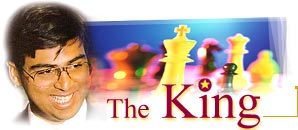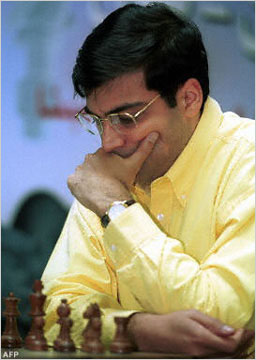
On the treadmill
To understand why the top players don't play the FIDE championship circle, you only need to review Anand's assault on the world championship title in late 1997-early 1998.
In December, Anand entered the cycle when he, along with over 100 of the top players in the world, arrived in Groningen, Netherlands, for the short, sharp, knockout rounds.
Anand entered the cycle in round two, as did the other leading grandmasters. In this round, each match was played over two games, with a time control of 40 moves in 100 minutes, followed by 20 moves in 50 minutes, followed by all remaining moves in 10 minutes, with each player receiving an additional 30 seconds thinking time as bonus for each move played.
If the scores stayed level after two games, two tie-break games were then played. These games started with 25 minutes on the clock, ten seconds being added after every move. If the score stayed level, then two more games were played, with just 15 minutes on the clock and 10 seconds bonus after each move. If the scores still stayed level, then the two players would go into Sudden Death mode.
 Sudden Death games were played with white having four minutes on the clock and black having five. Each move played gave the player a 10 second bonus. And the first game to produce a result counted, with the winner advancing to the next round.
Sudden Death games were played with white having four minutes on the clock and black having five. Each move played gave the player a 10 second bonus. And the first game to produce a result counted, with the winner advancing to the next round.
In round two, Anand went up against Predrag Nikolic, and defeated him in two straight games. Which set up a third round encounter with Alexander Khalifman -- who, you will recall, was later to go on to win the FIDE world title for the year 1999.
This round underlined the risk of playing the full cycle. The two players drew a scrappy first game. In the second, Anand in the early stages seemed in major trouble. In fact, he was to say later, "I was thinking about when to book my flight back home." He then pulled off a remarkable display of defensive chess to force a draw, forcing the game into the tiebreaker rounds. The first two games again ended in draws. Then came the 15 minute blitz games -- and Anand finally found the answer to Khalifman's no-risk style of play, creating sweeping attacks to win both.
That encounter appeared to have drained Anand -- and made him more determined to go for quick kills in succeeding rounds, even if it meant taking dangerous risks. In round four,
Anand faced Zoltan Almasi and facing Zoltan Almasi and the assembled experts where stunned when, after playing a slightly inferior opening, Anand declared an offer of draw, and played a very risky line. Almasi realised that the Indian was vulnerable, and went for the kill. At which point, again, Anand's defensive skills came to the fore, he tied up the position and forced Almasi into time trouble. Once his opponent was forced onto the ropes, Anand abandoned his defensive posture, and completely outplayed his opponent with a stunning display of high-risk, nerve-stretching chess.
In round five, Anand faced Alexei Shirov in a Spanish Opening. His preparation was good -- "I anticipated the Spanish", he said later -- and after avoiding early complications, Anand methodically mounted a winning attack, then held off his opponent to draw the second game and advance into the next round.
The sixth round comprised of four players -- Boris Gelfand, Nigel Short, Michael Adams and Anand himself. Anand was paired against Gelfand, and the first game, a Semi-Slav Defence with Anand playing black, began with white having a clear advantage in the opening.
Anand quickly repaired his position, forcing the game into a draw-ish position before the opening was completely played out. The draw was offered after 18 moves, and duly accepted. Game two went into a Sicilian, with Anand playing the opening very well to create a positional advantage for himself, which he then reinforced with a superb queen exchange on move 33 that pretty much ended Gelfand's resistance.
On the other table, Michael Adams defeated Nigel Short. Anand and Adams thus squared off in round seven. In this round, the rules were changed, with the match being over four games, with a time control of 40 moves in 100 minutes, followed by 20 moves in 50 minutes, followed by all remaining moves in 10 minutes, with each player receiving a 30 second bonus for each completed move.
A draw after the four regular games would then force the match into tie-break, with two games based on the 25 minute time control format, then if needed two more games on the 15 minute clock, and if necessary, Sudden Death games with white having four minutes on the clock and black having five.
The four regular games between Anand and Adams ended in draws, the two blitz games that followed were draws, as were the next two 15-minute blitz games. Finally, the match went into Sudden Death mode, and Anand wrapped it up in a Queen's Gambit Declined to force the win.
By this point, Anand had played 19 high-pressure games, against top-notch opponents. With no breathing space whatsoever, he flew into Lausanne, for the final round. Meanwhile, Anatoly Karpov waited in Lausanne, resting, and preparing with his team of seconds.
Tomorrow, the Anand-Karpov games, reviewed
When we get to Anand versus Karpov, we will present a game, or games, from
that face off. But today, just for fun, we break from the format to give you
an unusual game -- Albert Einstein (playing white), an acolyte of the play
of Emmanuel Lasker, takes on his peer, the physicist Robert Oppenheimer.
Enjoy the game
The Full Series